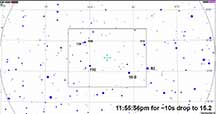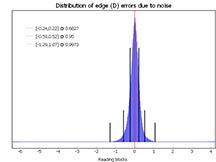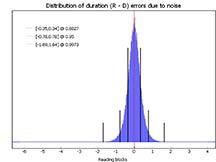The Occultation of a 13.4 Combined by Diomedes
Oct 31, 2020 at 11:55:56pm PDT
Preston predictions
Santa Cruz is on the centerline of this high rank event. However, it's at 89 degrees altitude, so it will require using a right angle setup to mount the Watec on the 8SE. And at 89 altitude, the rotation of the field during tracking will be very strong. Will require PyMovie for tracking, since the target will essentially disappear. Diomedes is magnitude 15.2. Another difficulty is the full moon will be only 30 degrees away. If skies are clean, it should be do-able. If there's significant smoke, it may not permit a high enough integration for the faint star and not saturate the sky brightness. The duration is 11.5 seconds, so it's forgiving of long integration times, except for this full moon problem.
My suggestion to minimize telescope rotation is to tilt the telescope by using uneven leg lengths, and such that the star will not get closer to the "up" direction of the telescope base until after the event.
The orientation of these charts cannot be trusted to agree with your telescope. The charts assume that the diagonal is used on the LCD chart. But the rotation of the chart may be different than seen here. This was plotted for a time about 20 minutes before the event.

Eyepiece view, assumes the usual diagonal ahead of the eyepiece. |

This chart assumes no diagonal even though the star is at the zenith; it assumes you can tilt the scope enough to use the straight-through configuration |

This chart assumes a diagonal ahead of the Watec. The rotational orientation can't be relied on. It depends on exactly when you aim the scope and what the tilt of your telescope is. |
|
|
Results
Our Central California Team had a success! Well, 2 out of 3 isn't bad, after all. Chris Kitting got a solid positive from Hayward, and Kirk Bender from near upper UCSC. I drove on to Locatelli Meadow... only to find I'd left my charts at home. I had to drive home; so that was almost an hour of critical time gone. I still got set up, at home now, so only a few miles from Kirk B's track. In my hurry, I didn't find the needed alignment stars that would give a good fix, settling for El Nath and Rigel, not that far apart. Too many obstructions from home. I had only a few minutes and was not able to identify the stars in the field that appeared in my eyepiece. I got no data. From now on, after printing charts, get up and place IMMEDIATELY into the folder and lay on the OccBox!
Kirk Bender's Results
Kirk had a 6.21 sec event from just past the upper meadow of UCSC with the 1.25" diagonal and 0.5x nosepiece focal reducer.
Kirk's PyOTE log file
Chris Kitting's Results
Chris had a 3.49s event, observed from Hayward with a 10" Newtonian on Atlas equatorial mount, with Watec 910hx and Sony recorder, and new digitizer to download.
Kitting's Pyote.csv and log file and LiMovie photometry csv







